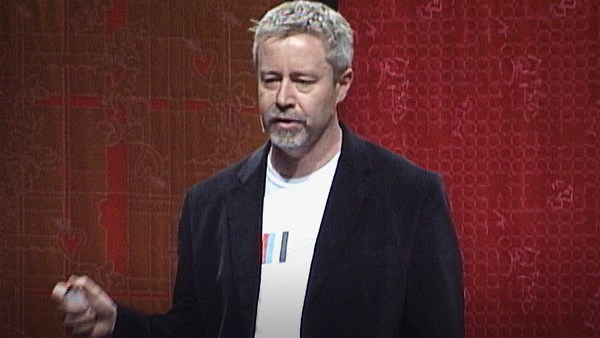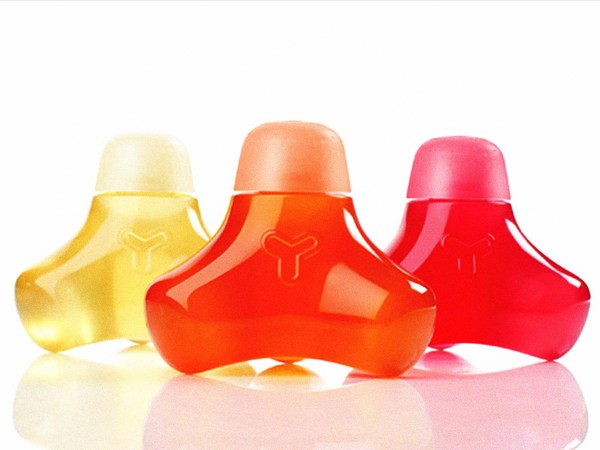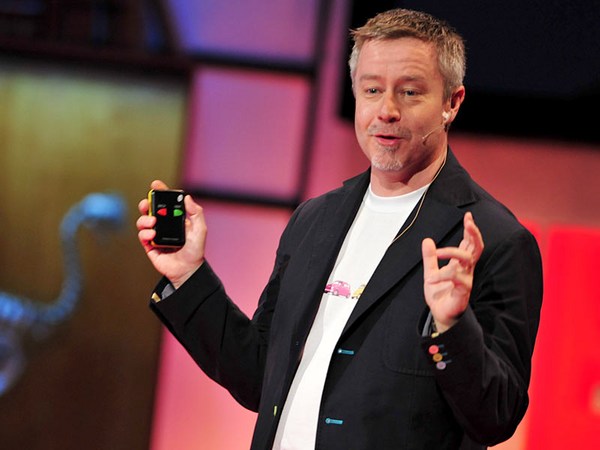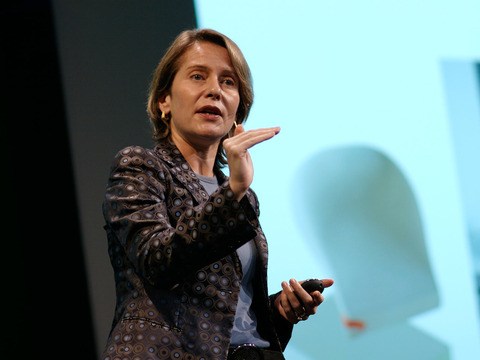Hello. Actually, that's "hello" in Bauer Bodoni for the typographically hysterical amongst us. One of the threads that seems to have come through loud and clear in the last couple of days is this need to reconcile what the Big wants -- the "Big" being the organization, the system, the country -- and what the "Small" wants -- the individual, the person. And how do you bring those two things together? Charlie Ledbetter, yesterday, I thought, talked very articulately about this need to bring consumers, to bring people into the process of creating things. And that's what I want to talk about today. So, bringing together the Small to help facilitate and create the Big, I think, is something that we believe in -- something I believe in, and something that we kind of bring to life through what we do at Ideo.
I call this first chapter -- for the Brits in the room -- the "Blinding Glimpse of the Bleeding Obvious." Often, the good ideas are so staring-at-you-right-in-the-face that you kind of miss them. And I think, a lot of times, what we do is just, sort of, hold the mirror up to our clients, and sort of go, "Duh! You know, look what's really going on." And rather than talk about it in the theory, I think I'm just going to show you an example. We were asked by a large healthcare system in Minnesota to describe to them what their patient experience was. And I think they were expecting -- they'd worked with lots of consultants before -- I think they were expecting some kind of hideous org chart with thousands of bubbles and systemic this, that and the other, and all kinds of mappy stuff. Or even worse, some kind of ghastly death-by-Powerpoint thing with WowCharts and all kinds of, you know, God knows, whatever.
The first thing we actually shared with them was this. I'll play this until your eyeballs completely dissolve. This is 59 seconds into the film. This is a minute 59. 3:19. I think something happens. I think a head may appear in a second. 5:10. 5:58. 6:20. We showed them the whole cut, and they were all completely, what is this? And the point is when you lie in a hospital bed all day, all you do is look at the roof, and it's a really shitty experience. And just putting yourself in the position of the patient --
this is Christian, who works with us at Ideo. He just lay in the hospital bed, and, kind of, stared at the polystyrene ceiling tiles for a really long time. That's what it's like to be a patient in the hospital. And they were sort, you know, blinding glimpse of bleeding obvious. Oh, my goodness. So, looking at the situation from the point of view of the person out -- as opposed to the traditional position of the organization in -- was, for these guys, quite a revelation. And so, that was a really catalytic thing for them. So they snapped into action. They said, OK, it's not about systemic change. It's not about huge, ridiculous things that we need to do. It's about tiny things that can make a huge amount of difference.
So we started with them prototyping some really little things that we could do to have a huge amount of impact. The first thing we did was we took a little bicycle mirror and we Band-Aided it here, onto a gurney, a hospital trolley, so that when you were wheeled around by a nurse or by a doctor, you could actually have a conversation with them. You could, kind of, see them in your rear-view mirror, so it created a tiny human interaction. Very small example of something that they could do. Interestingly, the nurses themselves, sort of, snapped into action -- said, OK, we embrace this. What can we do? The first thing they do is they decorated the ceiling. Which I thought was really -- I showed this to my mother recently. I think my mother now thinks that I'm some sort of interior decorator. It's what I do for a living, sort of Laurence Llewelyn-Bowen. Not particularly the world's best design solution for those of us who are real, sort of, hard-core designers, but nonetheless, a fabulous empathic solution for people. Things that they started doing themselves -- like changing the floor going into the patient's room so that it signified, "This is my room. This is my personal space" -- was a really interesting sort of design solution to the problem.
So you went from public space to private space. And another idea, again, that came from one of the nurses -- which I love -- was they took traditional, sort of, corporate white boards, then they put them on one wall of the patient's room, and they put this sticker there. So that what you could actually do was go into the room and write messages to the person who was sick in that room, which was lovely. So, tiny, tiny, tiny solutions that made a huge amount of impact. I thought that was a really, really nice example.
So this is not particularly a new idea, kind of, seeing opportunities in things that are around you and snapping and turning them into a solution. It's a history of invention based around this. I'm going to read this because I want to get these names right. Joan Ganz Cooney saw her daughter -- came down on a Saturday morning, saw her daughter watching the test card, waiting for programs to come on one morning and from that came Sesame Street. Malcolm McLean was moving from one country to another and was wondering why it took these guys so long to get the boxes onto the ship. And he invented the shipping container. George de Mestral -- this is not bugs all over a Birkenstock -- was walking his dog in a field and got covered in burrs, sort of little prickly things, and from that came Velcro.
And finally, for the Brits, Percy Shaw -- this is a big British invention -- saw the cat's eyes at the side of the road, when he was driving home one night and from that came the Catseye. So there's a whole series of just using your eyes, seeing things for the first time, seeing things afresh and using them as an opportunity to create new possibilities. Second one, without sounding overly Zen, and this is a quote from the Buddha: "Finding yourself in the margins, looking to the edges of things, is often a really interesting place to start." Blinkered vision tends to produce, I think, blinkered solutions. So, looking wide, using your peripheral vision, is a really interesting place to look for opportunity.
Again, another medical example here. We were asked by a device producer -- we did the Palm Pilot and the Treo. We did a lot of sexy tech at Ideo -- they'd seen this and they wanted a sexy piece of technology for medical diagnostics. This was a device that a nurse uses when they're doing a spinal procedure in hospital. They'll ask the nurses to input data. And they had this vision of the nurse, kind of, clicking away on this aluminum device and it all being incredibly, sort of, gadget-lustish. When we actually went and watched this procedure taking place -- and I'll explain this in a second -- it became very obvious that there was a human dimension to this that they really weren't recognizing. When you're having a four-inch needle inserted into your spine -- which was the procedure that this device's data was about; it was for pain management -- you're shit scared; you're freaking out. And so the first thing that pretty much every nurse did, was hold the patient's hand to comfort them. Human gesture -- which made the fabulous two-handed data input completely impossible.
So, the thing that we designed, much less sexy but much more human and practical, was this. So, it's not a Palm Pilot by any stretch of the imagination, but it has a thumb-scroll so you can do everything with one hand. So, again, going back to this -- the idea that a tiny human gesture dictated the design of this product. And I think that's really, really important. So, again, this idea of workarounds. We use this phrase "workarounds" a lot, sort of, looking around us. I was actually looking around the TED and just watching all of these kind of things happen while I've been here. This idea of the way that people cobble together solutions in our life -- and the things we kind of do in our environment that are somewhat subconscious but have huge potential -- is something that we look at a lot.
We wrote a book recently, I think you might have received it, called "Thoughtless Acts?" It's been all about these kind of thoughtless things that people do, which have huge intention and huge opportunity. Why do we all follow the line in the street? This is a picture in a Japanese subway. People consciously follow things even though, why, we don't know. Why do we line up the square milk carton with the square fence? Because we kind of have to -- we're just compelled to. We don't know why, but we do. Why do we wrap the teabag string around the cup handle? Again, we're sort of using the world around us to create our own design solutions. And we're always saying to our clients: "You should look at this stuff. This stuff is really important. This stuff is really vital." This is people designing their own experiences. You can draw from this. We sort of assume that because there's a pole in the street, that it's okay to use it, so we park our shopping cart there. It's there for our use, on some level.
So, again, we sort of co-opt our environment to do all these different things. We co-opt other experiences -- we take one item and transfer it to another. And this is my favorite one. My mother used to say to me, "Just because your sister jumps in the lake doesn't mean you have to." But, of course, we all do. We all follow each other every day. So somebody assumes that because somebody else has done something, that's permission for them to do the same thing. And there's almost this sort of semaphore around us all the time. I mean, shopping bag equals "parking meter out of order." And we all, kind of, know how to read these signals now. We all talk to one another in this highly visual way without realizing what we're doing. Third section is this idea of not knowing, of consciously putting yourself backwards. I talk about unthinking situations all the time. Sort of having beginner's mind, scraping your mind clean and looking at things afresh.
A friend of mine was a designer at IKEA, and he was asked by his boss to help design a storage system for children. This is the Billy bookcase -- it's IKEA's biggest selling product. Hammer it together. Hammer it together with a shoe, if you're me, because they're impossible to assemble. But big selling bookcase. How do we replicate this for children? The reality is when you actually watch children, children don't think about things like storage in linear terms. Children assume permission in a very different way. Children live on things. They live under things. They live around things, and so their spatial awareness relationship, and their thinking around storage is totally different. So the first thing you have to do -- this is Graham, the designer -- is, sort of, put yourself in their shoes. And so, here he is sitting under the table. So, what came out of this? This is the storage system that he designed. So what is this? I hear you all ask. No, I don't.
(Laughter)
It's this, and I think this is a particularly lovely solution. So, you know, it's a totally different way of looking at the situation. It's a completely empathic solution -- apart from the fact that teddy's probably not loving it.
(Laughter)
But a really nice way of re-framing the ordinary, and I think that's one of the things. And putting yourself in the position of the person, and I think that's one of the threads that I've heard again from this conference is how do we put ourselves in other peoples' shoes and really feel what they feel? And then use that information to fuel solutions? And I think that's what this is very much about. Last section: green armband. We've all got them. It's about this really. I mean, it's about picking battles big enough to matter but small enough to win. Again, that's one of the themes that I think has come through loud and clear in this conference is: Where do we start? How do we start? What do we do to start? So, again, we were asked to design a water pump for a company called ApproTEC, in Kenya. They're now called KickStart.
And, again, as designers, we wanted to make this thing incredibly beautiful and spend a lot of time thinking of the form. And that was completely irrelevant. When you put yourself in the position of these people, things like the fact that this has to be able to fold up and fit on a bicycle, become much more relevant than the form of it. The way it's produced, it has to be produced with indigenous manufacturing methods and indigenous materials. So it had to be looked at completely from the point of view of the user. We had to completely transfer ourselves over to their world. So what seems like a very clunky product is, in fact, incredibly useful. It's powered a bit like a Stairmaster -- you pump up and down on it. Children can use it. Adults can use it. Everybody uses it. It's turning these guys -- again, one of the themes -- it's turning them into entrepreneurs.
These guys are using this very successfully. And for us, it's been great because it's won loads of design awards. So we actually managed to reconcile the needs of the design company, the needs of the individuals in the company, to feel good about a product we were actually designing, and the needs of the individuals we were designing it for. There it is, pumping water from 30 feet. So as a final gesture we handed out these bracelets to all of you this morning. We've made a donation on everybody's behalf here to kick start, no pun intended, their next project. Because, again, I think, sort of, putting our money where our mouth is, here. We feel that this is an important gesture. So we've handed out bracelets. Small is the new big. I hope you'll all wear them. So that's it. Thank you.
(Applause)





